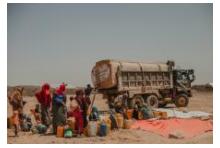The worst drought in decades is ravaging East Africa, destroying crops and driving the cost of food out of reach of many. Combined with the global pandemic and the fallouts from the war in Ukraine - who supplied 90% of East Africa's wheat imports - the consequences of the climate crisis means that millions are starving.
The IRC is calling for urgent action in Somalia, Ethiopia, and Kenya; 14 million people in these countries alone are on the verge of starvation. This number will rise to 20 million by September if drought conditions persist and if the world fails to fund crucial humanitarian responses in the region. By the time a famine is officially declared later this year, it will be too late to save hundreds of thousands of lives.
Women and children are among the groups who suffer most from climate change and food insecurity. When food resources are scarce, women and children are the ones most likely to eat less well and less frequently. Young children are also at exceptional risk of a climate-induced hunger crisis; between April and May 2022, one IRC clinic in Somalia saw a 265 percent increase in severely malnourished children under age 5.
Today, Ethiopia, Kenya, and Somalia make up 2% of the world’s population, but are home to 70% of the world’s most extremely food insecure. Despite repeated information campaigns by activists and other organizations involved in the humanitarian field, 85 percent of Americans and 80 percent of Britons are unaware of the famine threatening East Africa. This translates into a lack of funding and, tragically, needless death.
“Every day of inaction is a matter of life or death,” says IRC president and CEO David Miliband. “The crisis engulfing East Africa is emblematic of the failure of the international system: failure of prevention, failure of response and failure of leadership.“
East Africa is home to some of the IRC’s longest-running programs globally, with operations in Somalia for over 40 years, Kenya for 30 years, and Ethiopia for 20 years. Today, over 2,500 staff in the region are scaling up our programs to address the current drought and rising food insecurity, including expanding to new areas to meet needs. Our services run the gamut; they've included emergency relief, programs in water, health, nutrition, livelihoods, environmental health, child protection, economic recovery, and women’s empowerment, and conflict resolution.
It is already too late to stop people from dying, but there is still a window of opportunity to scale aid efforts to reduce the levels of death and suffering.
Give today to help families live full, healthy lives. Your gift allows us to deliver comprehensive aid to people affected by humanitarian crises and will be used where and when most needed.
